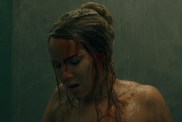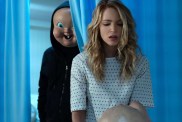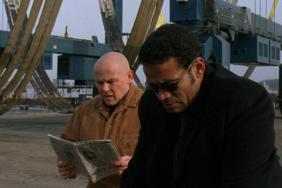Opening Friday, April 18th (limited)

Cast:
Willem Dafoe as Stan Aubray
Scott Speedman as Carl
Peter Stormare as Blair
Clea DuVall as Sandy
Directed by Henry Miller
Review:
It is both inevitable and unfortunate that the somber serial killer pic Anamorph will be judged against David Fincher’s 1995 epic Seven. So inevitable is the comparison that one need not even see the film — just read its logline (two detectives with differing methodologies track a homicidal artist hiding coded messages in his murders) — to begin noting similarities between the two. Of course, there’s not a serial killer movie made in the last 15 years that hasn’t owed an obvious debt to Fincher’s flick. The chief problem in this particular case is not that such a comparison undermines Anamorph‘s effectiveness or originality — but because it amplifies the lack thereof.
Returning to horror for the first time since 2000’s Shadow of the Vampire, Willem Dafoe once again puts the “character” in character actor, embodying world-weary detective Stan Aubray, haunted by his memories and consumed by the quest to catch a current-day killer. Five years prior Aubray, following a long chain of graphic murders and oblique clues, cracked the case of “Uncle Eddie,” a serial slayer who turned his victims into ghastly works of art. Aubray and his team thought they had identified and killed Eddie, an assumption the rest of the force and everyone else in this unidentified city were happy to endorse. But now a presumed copycat has picked up the torch and appears to be challenging Aubray, leaving a series of increasingly grotesque killings in his wake.
The rules and conventions of post-modern serial killer cinema are no mystery to director and co-writer Henry Miller. His film is covered in their fingerprints, from the washed-up detective assigned one last case to the washed-out color palette that makes every scene look like rain is coming. Naturally he grants Aubray a younger, looser, hotshot partner (Scott Speedman), as well as a surrogate daughter from the wrong side of the tracks (Clea Duvall), both of whom facilitate key plot points but do little else throughout the film. Also populating Miller’s dark city is a seemingly endless parade of quirky bit players and pseudo-celebrities, among them Blondie singer Debbie Harry (still just as gravely fetching as she was in David Cronenberg’s Videodrome, despite 25 years and plenty of makeup), former pro-wrestler Mick Foley, and, in a part that is the film’s most satisfying until he’s saddled with expository duties, Peter Stormare as a peppery antiques expert.
It is through Stormare’s mid-film slide-show that Aubray learns of “anamorphosis,” a Renaissance-era painting technique that reveals different images when viewed from opposing angles, which the new killer has applied to his elaborately staged crime scenes. It’s admittedly a clever, compelling approach â but one that’s ultimately irrelevant to the film. In fact, Anamorph is essentially a very simple story overcomplicated to a fault. Dafoe and Speedman hunt for leads and decipher clues less indicative of a homicidal mastermind and more of sloppy, pedestrian screenwriting. Characters pop in and out solely to add layers of suspicion, regardless of their validity. Even the murder sites themselves, though appreciably graphic in their depiction of the killer’s handiwork, test our limits with their contrived grandiosity (it should be noted, also, that almost all of the actually killing takes place off-screen). This is especially true in the film’s climactic reveal, where the use of the anamorphosis process is almost laughably executed.
Only a series of flashbacks aimed at fleshing out Aubray’s debilitating guilt works as it should, largely because Dafoe is the only face in the film whose character bears any degree of depth, but also because the story of what happened 5 years ago proves much more interesting than what’s happening in the present day. Miller attempts to invigorate things with creepy shadows and an asinine chase sequence, but there’s no outrunning the fact that we’ve been here so many times before in much more capable hands.
To their credit, Miller and cinematographer Fred Murphy (who also lensed Freddy Vs. Jason in similarly blue hues) know how to paint a frame of film. The composition and use of lighting in Anamorph are fantastic, at times reminiscent of Darren Aronofsky and Matthew Libatique’s unsettling work in Requiem for a Dream — the blend of fluid movement and stark framing making the film look more expensive than it likely was to create.
That gloss can’t fully hide the film’s blemishes, though, and with such mediocre results it’s hard to argue that it was worth whatever funds were utilized in bringing Anamorph to the screen. Art may be in the eye of the beholder, but no rose-colored glasses, no matter how blood-red they might be, could make this film any more appealing.










